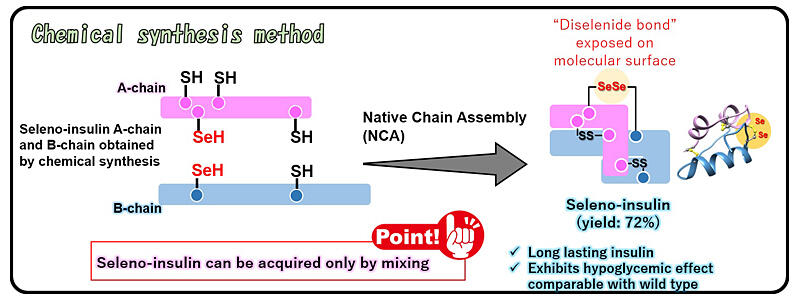An international collaborative research group composed of Research Unit Leader Kenta Arai and Professor Michio Iwaoka of the Department of Chemistry at Tokai University, Associate Professor Masaki Okumura of the Frontier Research Institute for Interdisciplinary Sciences and Professor Kenji Inaba of the Institute of Multidisciplinary Research for Advanced Materials at Tohoku University, Professor Hironobu Hojo of the Institute for Protein Research at Osaka University, and Professor Lee Young-Ho, Korea Basic Science Institute (KBSI) successfully synthesized artificial insulin (Seleno-Insulin) with a high efficiency by simply mixing two different polypeptide chains constituting insulin. The synthesized Seleno-Insulin showed high resistance to degradation owing to the formation of molecular aggregates and demonstrated an extended hypoglycemic effect. Through this study, the group proposed guidelines for the design of new long-acting formulations. The results were published in the electronic version of Communications Chemistry.

According to the World Health Organization, the number of adults with diabetes worldwide reached 537 million by 2021, and currently, approximately one in ten persons has diabetes. Insulin formulations are currently produced by cultivating genetically modified cells to harvest insulin, which is then subjected to chemical modifications. Studies on developing methods for synthesizing insulin solely through chemical reactions are ongoing.
In 2017, a research group with experts from Tokai University, Tohoku University, and Osaka University succeeded in chemically synthesizing Seleno-Insulin by replacing sulfur atoms, which are in disulfide bonds exposed on the molecular surface and formed between two different polypeptide chains (A and B chains) constituting insulin, with selenium atoms. They reported that Seleno-Insulin exhibited resistance to degradation against the insulin-degrading enzyme (IDE). However, the yield of the synthesis was only 27%, and the mechanism underlying the Seleno-Insulin's degradation resistance to IDE was not clear. Subsequently, this group developed an efficient chemical synthesis route for a wild-type insulin and established an efficient chemical synthesis method for insulin (NCA method) in 2018. Using the NCA method, simply mixing unmodified natural A and B chains resulted in insulin production with a yield of 49%.
This group applied the NCA method's reaction conditions and successfully produced Seleno-Insulin, with a high yield of 72%; they synthesized Seleno-Insulin from both the chemically unmodified Seleno-Insulin A and B chains in the reaction solution using a one-step (simple mixing) process. They also extensively investigated the IDE resistance of the synthesized Seleno-Insulin by varying its concentration. The results showed that the IDE resistance of Seleno-Insulin was higher than that of the wild-type insulin under all the applied concentration conditions. Upon mixing Seleno-Insulin with the wild-type insulin, the IDE resistance of the latter improved and became similar to that of Seleno-Insulin. IDE degrades insulin by engulfing the individual insulin molecules in its reaction pockets, possibly leading to the formation of oligomers.
To investigate the formation mechanism of insulin oligomers in detail, the group collaborated with KBSI and examined the formation behavior and thermal stability of soluble oligomers using analytical ultracentrifugation (AUC) and circular dichroism (CD) spectroscopy. The AUC analysis revealed that Seleno-Insulin formed dimers and hexamers at concentrations lower than that of the wild-type insulin. Seleno-Insulin formed similar oligomers when its concentration was lower than that of the wild-type insulin.
The less-degradable Seleno-Insulin is believed to remain in the body for an extended period, leading to a sustained hypoglycemic effect. Consequently, the group administered various types of insulin subcutaneously to normal and diabetic rats and monitored their blood glucose changes. The results showed that compared to the wild-type insulin, Seleno-Insulin sustained long-term hypoglycemic effects.
The existing long-acting insulin formulations delay the diffusion of insulin into the bloodstream by inducing insulin aggregation or by inhibiting its degradation (by binding it to other proteins). In this study, the molecular surface of insulin was chemically modified to form soluble oligomers, which delayed the IDE degradation and enabled prolonged retention in the body, resulting in pharmacological effects sustained for long periods. Based on the study results, a new design concept is proposed for the development of long-acting insulin formulations.
This article has been translated by JST with permission from The Science News Ltd. (https://sci-news.co.jp/). Unauthorized reproduction of the article and photographs is prohibited.




